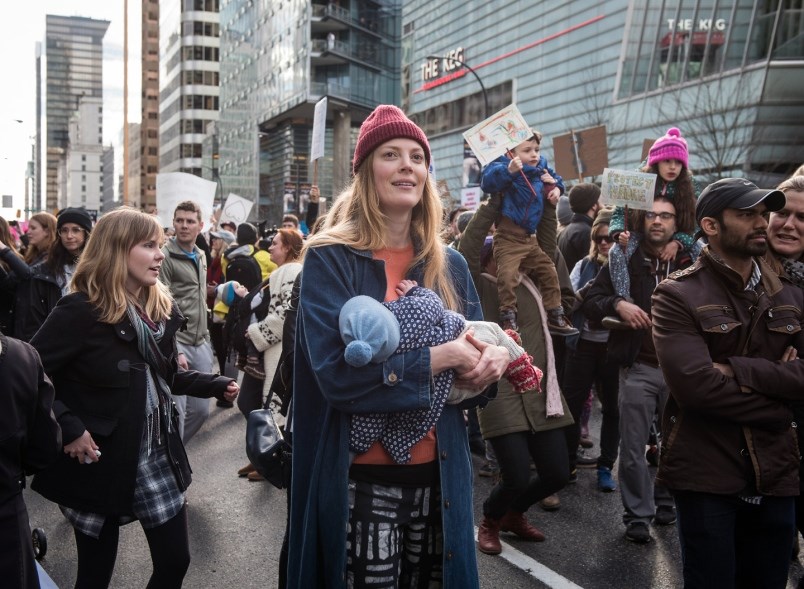This International Women’s Day, on March 8, 2017, women around the world will stop what they are doing at their workplace or in their home to highlight how vital women are to the economy. No national strike is planned for Canada, but advocacy groups in Vancouver are urging women to wear red to show their solidarity.
“The goal is to highlight the economic power that women have and their influence on the economy, while protesting the economic injustices women of all backgrounds continue to face,” explained Samantha Monckton, an organizer with March On! Vancouver, who helped plan Vancouver’s 15,000-strong Women’s March in January.
Though we have a feminist Prime Minister, Canadians have many reasons to ensure women’s rights are not taken for granted, not least of which is the fact that, for years, our elected officials have failed to give women’s equality its due.
Canada now stands at 25th place on the United Nation’s Gender Inequality Index, down from its first place ranking in 1995. Canada also ranked 35 out of 144 countries in the World Economic Forum’s 2016 Gender Gap Report — falling behind far poorer countries such as Bolivia, Cuba and the Philippines, which did better on measures related to economic opportunity, education, health and political empowerment.
Vancouverites should pay special attention. Women face more challenges here than their counterparts in other parts of the country. “B.C. is lagging behind the rest of Canada on multiple measures,” according to a Feb. 1 letter to Premier Christy Clark and B.C.’s NDP Leader John Horgan endorsed by 28 organizations focused on advancing women’s rights.
Canadian women earn 72 cents for every dollar Canadian men make, with women in B.C. earning less than women in other parts of Canada. In addition, families headed by single mothers in B.C. experience some of the highest rates of poverty and food insecurity in the country, the letter said. Our province also spends less per capita on legal aid than the national average, meaning that women who need the service to pay to help them leave violent partners don’t always get it.
A lack of political will is a major factor behind this decline, according to Kasari Govender, executive director of West Coast LEAF, a legal advocacy group and one of the organizations behind the letter. Some Canadians have become “complacent” because “big battles” related to gender equality have been fought on the surface, she said. “What remains to be done is some of the deeper work.”
For many women’s rights advocates in B.C. a key part of this “deeper work” involves convincing whichever party wins the May provincial election to commit to developing a $10-a-day child care program. So far, the NDP has made it part of its election platform.
Currently, regulated child care spaces are available for less than two out of 10 children under two in B.C. For those lucky enough to get a full-time spot for a toddler in a Vancouver daycare, the cost is comparable to renting an apartment, further squeezing families — and mothers — who may already be struggling with rising housing costs.
Consequently, access to affordable childcare could make a big difference for a variety of women, including single mothers and those who need to work to leave abusive relationships. In fact, it may be the key to breaking out of a cycle of poverty.
“They could work more secure jobs or high-paying jobs, or they could work full-time jobs instead of part-time jobs,” explained Kendra Milner, director of law reform at West Coast LEAF. “For really low-income women, having access to childcare is often a key support they need to get off of income assistance because [otherwise] they just can’t earn enough through work.”
It’s also good for the economy. Increasing women’s economic participation by giving them access to $10-a-day childcare could add more than 12,000 jobs and almost $1 billion to the provincial economy by 2020, according to a report commissioned by Early Childhood Educators of B.C. The study also predicts such a program would pay for itself, with the government gaining more income tax from women’s increased participation in the workforce than it costs to run the program.
These findings are in line with research from around the world. In fact, increasing women’s economic participation by advancing women’s equality could add as much as $12 trillion to the global economic growth, according to a 2016 study by McKinsey and Company. The reason why is pretty simple — currently, approximately half the world’s population is not achieving its full economic potential.
When women around the world strike on Wednesday, they’re sure to be missed. But there are also the women we don’t notice missing everyday — the ones with the desire to work or the potential to do better jobs who are held back by a lack of access to childcare and other factors that limit their opportunities. They’re the reason I’ll be wearing red on International Women’s Day.
alia.dharssi@gmail.com



